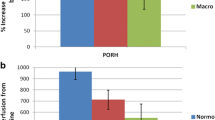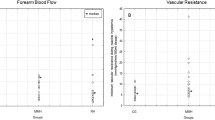Abstract
Background: Microalbuminuria in Type 2 diabetes is associated with arterial endothelial dysfunction, but the venous bed was never evaluated. Aim: To study the endothelial function in the venous and arterial bed in patients with Type 2 diabetes with normoalbuminuria or microalbuminuria. Material and methods: We evaluated 28 patients with Type 2 diabetes, glycated hemoglobin (HbA1c) <7.5%, who were classified as normo- (albuminuria <30 mg/24 h; no.=16) or microalbuminuric (albuminuria 30–300 mg/24 h; no.=12). Venous and arterial endothelial function were assessed by the dorsal hand vein technique (venodilation by acetylcholine) and brachial artery flow-mediated vasodilation, respectively. Results: Patients were normotensive (systolic arterial pressure: 131.1±10.6 mmHg) and on good metabolic control (HbA1c: 6.6±0.6%). Microalbuminuric patients presented impaired venous (32.9±17.4 vs 59.3±26.5%; p=0.004) and arterial vasodilation (1.8±0.9 vs 5.1±2.4; p<0.001), as compared to normoalbuminuric patients. There was a negative correlation between acetylcholine-induced venodilation and albuminuria (r=−0.62; p<0.001) and HbA1c (r=−0.41; p=0.032). The same was observed between flow-mediated arterial vasodilation and albuminuria (r=−0.49; p=0.007) and HbA1c (r=−0.44; p=0.019). Venous and arterial vasodilation was positively correlated (r=0.50; p=0.007). Conclusions: Both venous and arterial endothelial function are impaired in Type 2 microalbuminuric diabetics, in spite of good metabolic control, suggesting that other factors are involved in its pathogenesis.
Similar content being viewed by others
References
Mogensen CE. Microalbuminuria predicts clinical proteinuria and early mortality in maturity-onset diabetes. N Engl J Med 1984, 310: 356–60.
Damsgaard EM, Froland A, Jorgensen OD, Mogensen CE. Microalbuminuria as predictor of increased mortality in elderly people. BMJ 1990, 300: 297–300.
Weir MR. Microalbuminuria and cardiovascular disease. Clin J Am Soc Nephrol 2007, 2: 581–90.
Yu Y, Suo L, Yu H, Wang C, Tang H. Insulin resistance and endothelial dysfunction in type 2 diabetes patients with or without microalbuminuria. Diabetes Res Clin Pract 2004, 65: 95–104.
Ladeia AM, Ladeia-Frota C, Pinho L, Stefanelli E, Adan L. Endothelial dysfunction is correlated with microalbuminuria in children with short-duration type 1 diabetes. Diabetes Care 2005, 28: 2048–50.
Kocsis E, Pacher P, Pósa I, Nieszner E, Pogátsa G, Koltai MZ. Hyperglycaemia alters the endothelium-dependent relaxation of canine coronary arteries. Acta Physiol Scand 2000, 169: 183–7.
Papaioannou GI, Seip RL, Grey NJ, et al. Brachial artery reactivity in asymptomatic patients with type 2 diabetes mellitus and microalbuminuria (from the detection of ischemia in asymptomatic diabetics-brachial artery reactivity study). Am J Cardiol 2004, 94: 294–9.
Cosson E, Pham I, Valensi P, Paries J, Attali JR, Nitenberg A. Impaired coronary endothelium-dependent vasodilation is associated with microalbuminuria in patients with type 2 diabetes and angiographically normal coronary arteries. Diabetes Care 2006, 29: 107–12.
Cooper ME, Gilbert RE, Jerums G. Diabetic vascular complications. Clin Exp Pharmacol Physiol 1997, 24: 770–5.
Aellig WH. A new technique for recording compliance of human hand veins. Br J Clin Pharmacol 1981, 11: 237–43.
Signori LU, Silva AMV, Plentz RDM, et al. Reduced venous endothelial responsiveness after oral lipid overload in healthy volunteers. Metabolism 2008, 57: 103–9.
Silva AMV, Signori LU, Plentz RDM, et al. Hemodialysis improves endothelial venous function in end-stage renal disease. Braz J Med Biol Res 2008, 41: 482–8.
Corretti MC, Anderson TJ, Benjamin EJ, et al. Guidelines for the ultrasound assessment of endothelial-dependent flow-mediated vasodilation of the brachial artery: a report of the International Brachial Artery Reactivity Task Force. J Am Coll Cardiol 2002, 39: 257–65.
Stehouwer CD, Gall MA, Twisk JW, Knudsen E, Emeis JJ, Parving HH. Increased urinary albumin excretion, endothelial dysfunction, and chronic low-grade inflammation in type 2 diabetes: progressive, interrelated, and independently associated with risk of death. Diabetes 2002, 51: 1157–65.
Makino H, Okada S, Nagumo A, et al. Decreased circulating CD34+ cells are associated with progression of diabetic nephropathy. Diabet Med 2009, 26: 171–3.
Harada K, Ohmori M, Kitoh Y, Sugimoto K, Fujimura A. Impaired beta-adrenoceptor mediated venodilation in patients with diabetes mellitus. Br J Clin Pharmacol 1999, 47: 427–31.
Vischer UM, Emeis JJ, Bilo HJ, et al. von Willebrand factor (vWf) as a plasma marker of endothelial activation in diabetes: improved reliability with parallel determination of the vWf propeptide (vWf: AgII). Thromb Haemost 1998, 80: 1002–7.
Makino H, Doi K, Hiuge A, et al. Impaired flow-mediated vasodilatation and insulin resistance in type 2 diabetic patients with albuminuria. Diabetes Res Clin Pract 2008, 79: 177–82.
Cohen ND, Dunstan DW, Robinson C, Vulikh E, Zimmet PZ, Shaw JE. Improved endothelial function following a 14-month resistance exercise training program in adults with type 2 diabetes. Diabetes Res Clin Pract 2008, 79: 405–11.
Bagg W, Whalley GA, Gamble G, Drury PL, Sharpe N, Braatvedt GD. Effects of improved glycaemic control on endothelial function in patients with type 2 diabetes. Intern Med J 2001, 31: 322–8.
Vehkavaara S, Yki-Järvinen H. 3.5 years of insulin therapy with insulin glargine improves in vivo endothelial function in type 2 diabetes. Arterioscler Thromb Vasc Biol 2004, 24: 325–30.
Lüscher TF, Noll G. Endothelial function as an end-point in interventional trials: concepts, methods and current data. J Hypertens Suppl 1996, 14 (Suppl 2): S111–9.
Author information
Authors and Affiliations
Corresponding author
Rights and permissions
About this article
Cite this article
Silva, A.M.V., Schaan, B.D., Signori, L.U. et al. Microalbuminuria is associated with impaired arterial and venous endothelium-dependent vasodilation in patients with Type 2 diabetes. J Endocrinol Invest 33, 696–700 (2010). https://doi.org/10.1007/BF03346672
Accepted:
Published:
Issue Date:
DOI: https://doi.org/10.1007/BF03346672




